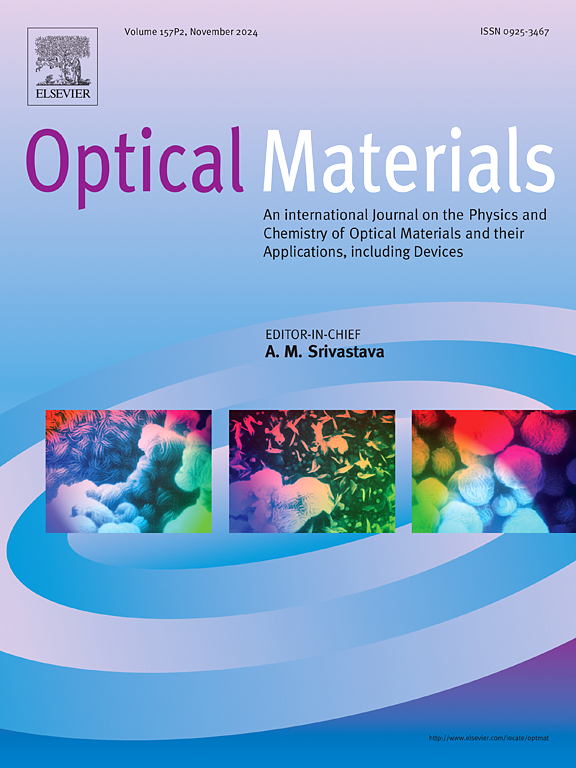Comparative study on visible-infrared and upconversion luminescence of Er3+,Yb3+ Co-doped La2Zr2O7 and Y2Zr2O7 phosphors for optical thermometry and latent fingerprint detection
IF 4.2
3区 材料科学
Q2 MATERIALS SCIENCE, MULTIDISCIPLINARY
引用次数: 0
Abstract
This study presents a comprehensive comparison of the structural and optical characteristics of rare-earth activated La2Zr2O7 (LZO) and Y2Zr2O7 (YZO) phosphors, each being synthesized by both the combustion method (CMB) as well as the microwave hydrothermal (MHT) method. The structural characterization confirmed the successful formation of both compounds without impurity phases. The optical characterization studies, including photoluminescence (PL) under UV excitation and upconversion photoluminescence (UCPL) under 980 nm and 1550 nm laser excitation, reveal distinct luminescent properties. Under 378 nm excitation, both phosphor systems exhibit emissions spanning the visible (500–725 nm) and near-infrared (900–1600 nm) regions, with peak intensities at 545 nm, 980 nm, and 1530 nm. The UCPL results shows enhanced green emission for Er3+,Yb3+ co-doped LZO and red emission for Er3+,Yb3+ co-doped YZO upon 980 nm laser excitation. Under 1550 nm laser excitation, the Er3+-doped samples exhibit superior luminescence compared to Er3+,Yb3+ co-doped counterparts. Optical thermometry studies indicate that the LZO:Er3+,Yb3+ sample prepared by MHT method achieved a maximum absolute sensitivity of 54 × 10−4 K−1 at 393 K and 30.7 × 10−4 K−1 at 313 K for 980 nm, 1550 nm laser excitations, respectively. Similarly, the YZO:Er3+,Yb3+ sample prepared by the CMB method achieved a maximum absolute sensitivity of 22 × 10−4 K−1 at 433 K and 17.2 × 10−4 K−1 at 353 K for 980 nm, 1550 nm laser excitations, respectively. Besides optical thermometry studies, the brightest sample, LZO:Er3+,Yb3+ synthesized via MHT method, demonstrated strong green luminescence under 980 nm laser excitation, offering potential for latent fingerprint detection applications.
Er3+、Yb3+共掺杂La2Zr2O7和Y2Zr2O7荧光粉在光学测温和潜在指纹检测中的可见-红外和上转换发光比较研究
本研究全面比较了稀土活化的La2Zr2O7 (LZO)和Y2Zr2O7 (YZO)荧光粉的结构和光学特性,分别采用燃烧法(CMB)和微波水热法(MHT)合成。结构表征证实了这两种化合物的成功形成,没有杂质相。紫外激发下的光致发光(PL)和980 nm和1550 nm激光激发下的上转换光致发光(UCPL)的光学表征研究显示了不同的发光特性。在378nm激发下,两种荧光粉系统都表现出跨越可见光(500 - 725nm)和近红外(900 - 1600nm)区域的发射,峰值强度分别为545nm、980nm和1530nm。UCPL结果表明,在980 nm激光激发下,Er3+、Yb3+共掺杂LZO的绿色发射增强,Er3+、Yb3+共掺杂YZO的红色发射增强。在1550 nm激光激发下,Er3+掺杂样品的发光性能优于Er3+、Yb3+共掺杂样品。光学测温研究表明,MHT法制备的LZO:Er3+、Yb3+样品在980 nm、1550 nm激光激发下,在393 K和313 K下的最大绝对灵敏度分别为54 × 10−4 K−1和30.7 × 10−4 K−1。同样,CMB法制备的YZO:Er3+、Yb3+样品在433 K和353 K下的最大绝对灵敏度分别为22 × 10−4 K−1和17.2 × 10−4 K−1,分别为980 nm、1550 nm激光激发。除光学测温研究外,通过MHT方法合成的最亮样品LZO:Er3+,Yb3+在980 nm激光激发下表现出强烈的绿色发光,具有潜在的指纹检测应用潜力。
本文章由计算机程序翻译,如有差异,请以英文原文为准。
求助全文
约1分钟内获得全文
求助全文
来源期刊

Optical Materials
工程技术-材料科学:综合
CiteScore
6.60
自引率
12.80%
发文量
1265
审稿时长
38 days
期刊介绍:
Optical Materials has an open access mirror journal Optical Materials: X, sharing the same aims and scope, editorial team, submission system and rigorous peer review.
The purpose of Optical Materials is to provide a means of communication and technology transfer between researchers who are interested in materials for potential device applications. The journal publishes original papers and review articles on the design, synthesis, characterisation and applications of optical materials.
OPTICAL MATERIALS focuses on:
• Optical Properties of Material Systems;
• The Materials Aspects of Optical Phenomena;
• The Materials Aspects of Devices and Applications.
Authors can submit separate research elements describing their data to Data in Brief and methods to Methods X.
 求助内容:
求助内容: 应助结果提醒方式:
应助结果提醒方式:


